Heading out the door? Read this article on the new Outside+ app available now on iOS devices for members! Download the app.
As yogis, most of us continually strive to move through life more mindfully. Yet sometimes, despite our best efforts, we run into obstacles and react in ways that don’t serve us. We vow to cut back on sugar, then cave at the sight of cookies; we get down on ourselves for playing the comparison game when looking at social media feeds; we feel frustrated if we can’t balance in Bakasana (Crane Pose) during yoga class. Often, these roadblocks are tied to our samskaras, the Sanskrit term for the mental and emotional grooves, or habits, that we find ourselves falling back into time and time again.
Whether conscious or unconscious, positive or negative, samskaras make up our conditioning and influence how we respond in certain situations. Changing these deeply ingrained patterns can be difficult—even if those patterns cause us pain. The good news is that we can use our yoga practice to examine our samskaras, identify what may be getting in the way of realizing our best intentions, and work with what we uncover.
By observing our reactive patterns on the yoga mat and meditation cushion, we’re better able to recognize when we react mindlessly in real life—and in turn, consciously shift our feelings, thoughts, emotions, moods, and behaviors. For example, if you lose your balance in Vrksasana (Tree Pose), look at how you talk to yourself. Are you kind? Or do you beat yourself up? Can you dust yourself off and try again, even when you feel like giving up?
The most common roadblocks I see students struggle with on a regular basis are self-criticism, frustration, and lack of willpower. The following sequence will help you cultivate the tools you need to work through your roadblocks, so you can break the patterns that no longer serve you and call in new ones that will help you live more mindfully.
See also 16 Yoga Poses to Keep You Grounded & Present
Balasana, variation (Child’s Pose)
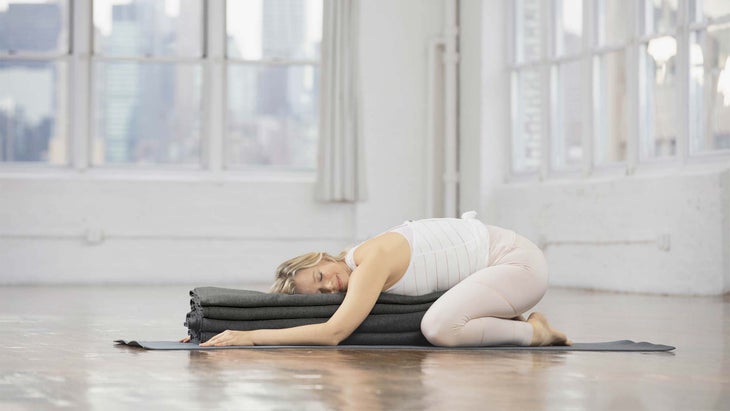
Come to rest on your shins, knees hip-width apart. Fold four blankets in half lengthwise, and place them between your thighs. Rest your torso on the blankets with your elbows bent on the floor and your head turned to one side. If your elbows don’t touch the ground, place additional blankets under your forearms. If your back feels excessively rounded, remove one blanket. Stay here for at least 5 minutes. Halfway through, turn your head to the other side. This pose turns our attention inward and offers a safe, supportive space for us to surrender and let go.
See also Find Comfort in Child’s Pose
Downward-Facing Dog Pose, variation
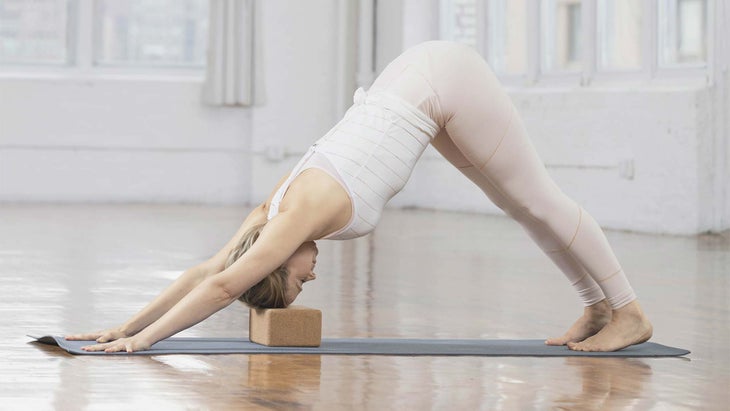
From Child’s Pose, stretch your arms out long in front of you. Check that your hands are shoulder-width apart and press your hands into the mat to straighten your arms. Shift forward to your hands and knees, curl your toes under, and pull your thighs back into Down Dog. Place a block on any height (you can also use folded blankets or a bolster) under the crown of your head. Press the tops of your thighs back, moving more weight into your legs. Stretch your hands forward and your heels back. Allow the block to hold the weight of your head as you stay here for 1 minute. This incredibly grounding variation of Downward-Facing Dog gives your mind a place to rest—literally.
See also What You Didn’t Learn in YTT: How to Skillfully Modify Yoga Classes on the Fly
Parivrtta Janu Sirsasana, variation (Revolved Head-to-Knee Pose)
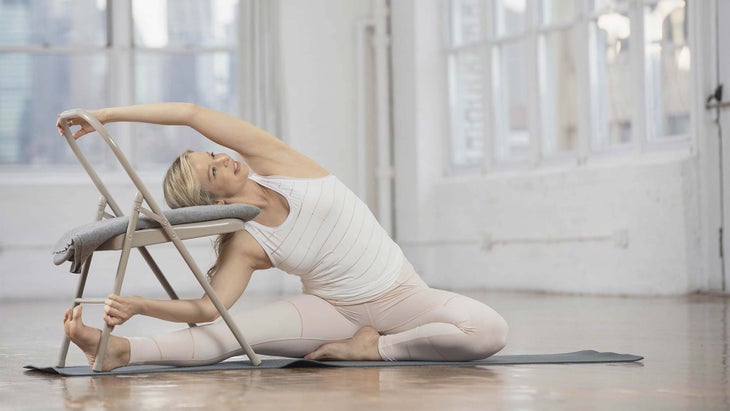
Sit down facing a chair, and stretch your legs out in front of you (under the chair). Fully bend your left knee and externally rotate your left thigh. Pull your left hip back behind the right so that your pelvis opens slightly to the left. On an inhalation, lift up through the sides of your waist to elongate your spine. On an exhalation, twist to the left. Sidebend your torso toward your right foot and reach your right hand inside the chair to grab whichever chair leg feels accessible to you. Stretch your left arm up and overhead, and grab the back of the chair. Rest the base of your skull, supported by a blanket or two, on the chair seat.
Gently rotate your chest up toward the ceiling and stay here for 5 minutes. This pose opens up the side body and creates an expansive quality that can help you cultivate more space and softness within yourself. Note: If your tailbone is curling underneath you or your bent knee is high off the ground, sit higher up on a blanket or two. Repeat on the other side.
See also Master Revolved Abdomen Pose
Upavistha Konasana (Wide-Angle Seated Forward Bend)
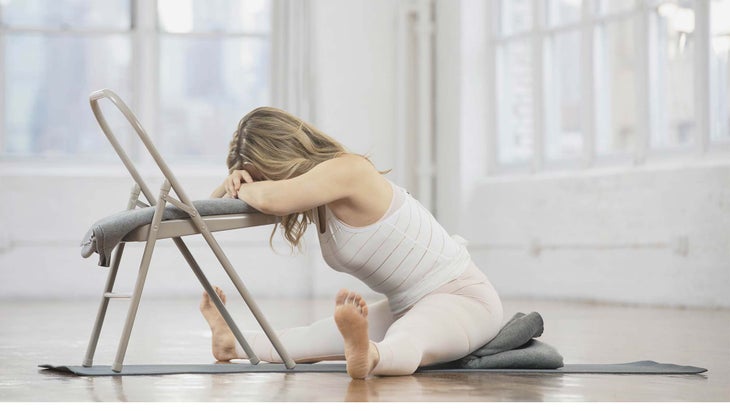
Sit down facing a chair and open your legs wide apart. Press your upper thighs down into the mat to activate your legs, and hinge forward at your hips, lengthening your torso toward the chair. Rest your forehead, supported by a blanket or two, on the chair seat.
Bend your elbows and rest your hands on the chair seat. Stay here for 5 minutes. The chair invites us to surrender and turn inward. Note: If you feel tight in your hamstrings, or if your tailbone is tucking under, sit on a blanket or two.
See also Forward Bend Yoga Poses
Savasana, variation (Corpse Pose)
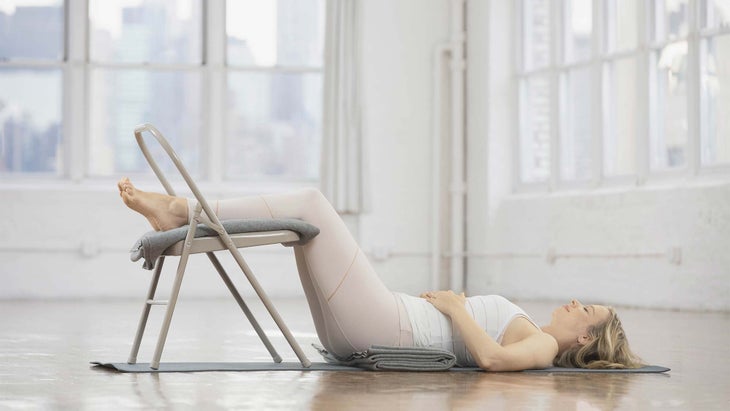
Place a blanket on the seat of the chair. Fold a second blanket in half lengthwise and set it aside. Lie down on your back and rest your calves on the seat of the chair. Lift your hips up and slide the folded blanket under your sacrum, then bend your elbows and rest your hands on your torso. Surrender and breathe here for at least 5 minutes. This incredibly supportive variation of Savasana encourages a deep release.
See also 7 Heart-Freeing Camel Pose Variations from Carrie Owerko
See also A Katonah Yoga Sequence to Live a More Abundant Life
